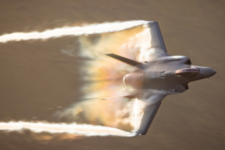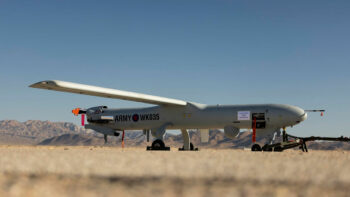
US Air Force artist’s rendering of the Sentinel in flight. (Credit: US Air Force)
SYDNEY — In what is likely her last interview as acting US Air Force Undersecretary, Kristyn Jones said today that the Nunn-McCurdy review of the troubled Sentinel ICBM program has uncovered a lesson all Pentagon programs must bear in mind when building on an existing capability: Don’t assume there’s significantly less risk just because there’s an existing infrastructure.
The first flight of the Air Force’s replacement for the nuclear-armed Minuteman III ballistic missile fleet has slipped by over two years, and its budget soared 37 percent to a new total of more than $130 billion.
While Jones did not think the requirements process was flawed, she exclusively told Breaking Defense that problems often arose with “the interpretation of those requirements and how they could be met down to the specification level. That resulted in cost and schedule growth. So making sure that those requirements are reviewed or validated, that they are cost informed, that the right engineering rigor is applied before moving forward to the next key decision points or milestones.”
RELATED: ‘We will have to find the money’: After cost breach, USAF doubles down on Sentinel ICBM
In addition to the underestimation of risk, Jones said “the management structure” of both the government and of industry, led by Northrop Grumman in this case with Bechtel taking a large role as well, was not sufficiently transparent. It’s likely the Nunn-McCurdy report will advise the federal government and companies needs to be more transparent, provide “the right level of oversight, the right governance” and make sure “all of those things are working together,” she said.
Jones spoke in Sydney at the AusSapce Conference here and she’ll next head to Williamtown, New South Wales, where Australia’s F-35s and Wedgetail surveillance aircraft are based. The US Air Force has indicated it wants to buy the E-7, but negotiations with manufacturer Boeing have been dragging on. Earlier this month, the Air Force’s top acquisition official, Andrew Hunter, told Breaking Defense the Air Force and Boeing were close to resolving a pricing disagreement that has held up the deal for the first two E-7 Wedgetails, saying a final agreement could happen within weeks.
Jones said that when US officials looked closely at the Australian Boeing-built aircraft, they realized it might not be able to do what they needed it to do.
“As more was learned about what we’re trying to do, versus the current capabilities, that impacted the cost of the program,” she noted. “And so the department has been working very hard to make sure that we have an affordable program that still meets the requirements.” She reaffirmed Hunter’s statement that the two sides were very close.
After Williamtown, Jones will go to Canberra to meet with Australian and US embassy officials in the capital. Since the undersecretary oversees both the Air Force and the Space Force, the ambit of topics will doubtless be wide. There’s the crucial Deep-Space Advanced Radar Capability, designed by Johns Hopkins Applied Physics Laboratory to provide global monitoring of geosynchronous orbits in all kinds of weather and during daylight, that will be built in Australia.
One of the biggest jobs she’s had over the last few months has been shepherding the Air Force’s and Space Force’s portions of the Program Objective Memorandum (aka the budget request). There may be good news for the Space Force, which currently faces a flat budget.
“The ’24 and ’25 [budgets] were dictated by the Fiscal Responsibility Act requirements,” she noted, adding that she’s “optimistic that more of the needed Space Force capabilities will be funded this year.”
Back in the US, Jones will be stopping in Los Angeles on her way back to DC and to meet with Space Systems Command. When Jones gets back to Washington, her successor as undersecretary will soon be sworn in. Melissa Dalton was confirmed by the US Senate on May 23. Jones has been performing the duties of the office since former Air Force Undersecretary Gina Ortiz Jones stepped down in March 2023.






















